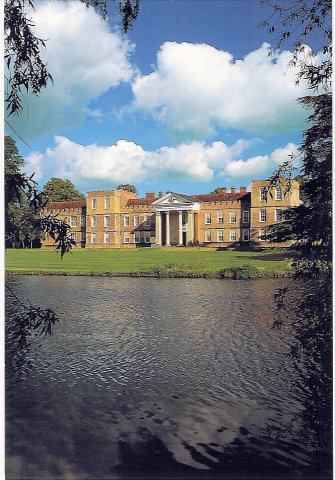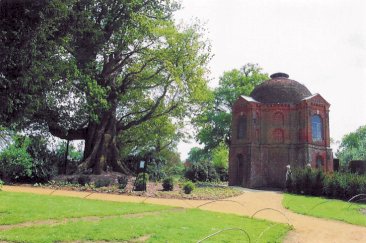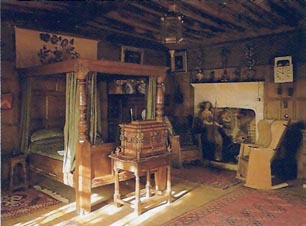The Scandal of Lord Randal
The Vyne

Trentingham Manorfrom across the river. Note the classical portico that was added in the 17th Century.
Trentingham Manor was inspired by The Vyne, a National Trust property in Hampshire (which I relocated to sit on the banks of the Thames). Built in the early 16th century for Lord Sandys, Henry VIII's Lord Chamberlain, the house acquired a classical portico in the mid–17th century (the first of its kind in England) and contains a grand Palladian staircase, a wealth of old paneling and fine furniture, and a fascinating Tudor chapel with Renaissance glass. The Vyne and its extensive gardens are also open for visits April through October.
 The summerhouse beside the
The summerhouse beside the twenty-guinea oak.
Ham House

Hawkridge Hall was modeled on Ham House in Surrey. Known as the most well-preserved Stuart home in England, Ham House was built in 1610 and enlarged in the 1670s. The building has survived virtually unchanged since then, and it still retains most of the furniture, pictures, and interior decoration from that period. Ham House was owned by the Lauderdales, one of the most powerful families in Restoration England, and a visit gives a wonderful picture of 17th century aristocratic life. Now owned by the National Trust, the house and gardens are open daily from April through October.
 The Great Hall.
The Great Hall.
Edmond Halley's House

Rand's house in Oxford was inspired by the house Edmond Halley lived in while he held the post of Oxford's Savilian Professor of Geometry from 1703–1742. If you visit Oxford, look for the house in New College Lane near the Bridge of Sighs. The building isn't open to tourists, but you can see the outside, including the rooftop observatory Halley added (although he never saw Halley's Comet from it, since it made no appearance between 1682 and his death).
Snowshill Manor

Though I moved it to the Thames, Lakefield House was loosely modeled on Snowshill Manor in Gloucestershire. Snowshill was owned by Winchcombe Abbey from the year 821 until the reign of Henry VIII in the 16th century, when, with the dissolution of the monasteries, it passed to the Crown. Thereafter it had many owners and tenants until 1919, when a man named Charles Paget Wade returned from the First World War and found it for sale. The house was derelict, the garden an overgrown jumble of weeds, including—of course!—a sundial.
 A bedroom in Snowshill. (My model for Ford's bedroom pre-renovations.)
A bedroom in Snowshill. (My model for Ford's bedroom pre-renovations.)
Wade bought Snowshill and restored it, removing the plaster ceilings, moving partitions back to their original places, unblocking fireplaces, and fitting Tudor paneling to many of the rooms to recapture the original atmosphere. He scorned the use of electricity and modern conveniences, so the house appears today much as it would have during Ford's time. Wade never lived in the house, instead using it to showcase his amazing collection of everyday and curious objects, literally thousands of items including musical instruments, clocks, toys, bicycles, weavers' and spinners' tools, and Japanese armor. The home is now owned by the National Trust and open April through October to view the house and collection.









